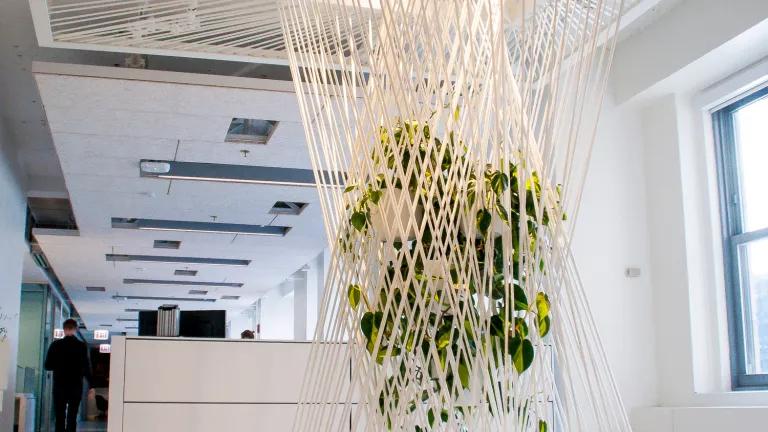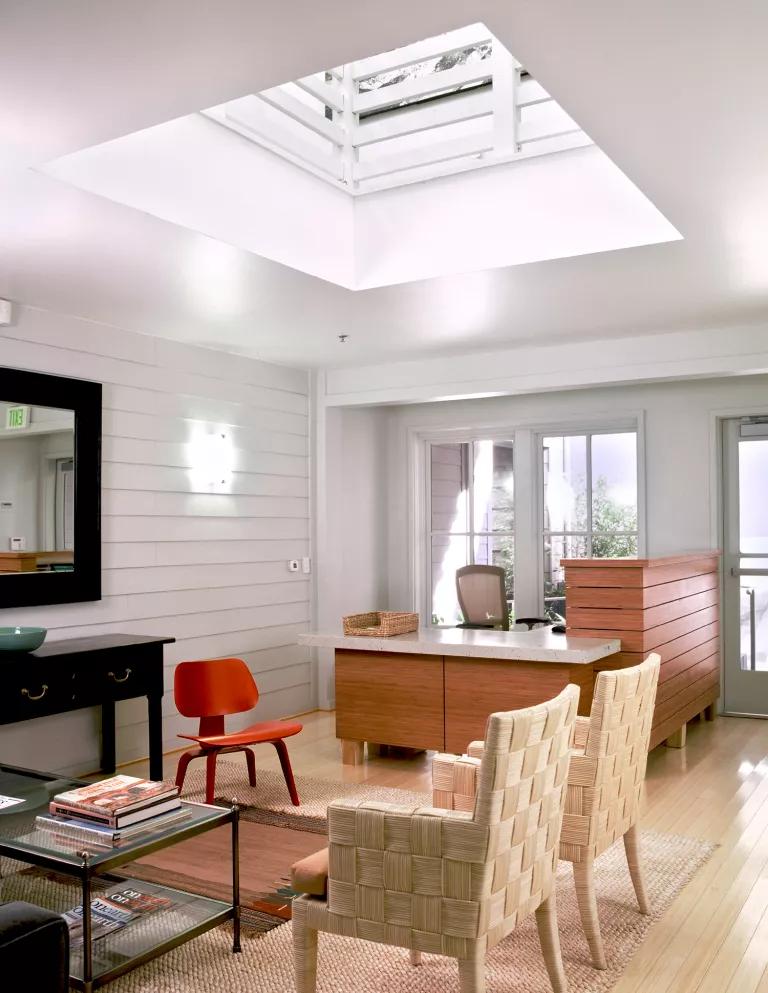NRDC's Commitment to Green Starts with Its Offices
Each one of our six workplaces in the United States and China is a model of earth-friendly design.

NRDC’s environmental principles are put into practice through the incorporation of innovative green design in its own offices. Its New York City, Chicago, San Francisco, Santa Monica, Washington, D.C., and Beijing workplaces embody sustainable building concepts, making them even more comfortable and productive places to work.
The first of these eco-conscious offices was created in 1988, when green design was novel and largely untested in real-life settings. NRDC’s New York City headquarters, housed in the top floors of an Art Deco building in the Flatiron district, is filled with abundant natural light. By embracing this brightness and incorporating cost-effective technologies and materials, NRDC’s home base became a shining example of sustainable renovation. The space also requires 70 percent less energy than do conventional offices.
That was just the beginning. Since the opening of NRDC’s retrofitted Flatiron home, the organization has taken advantage of major advances in planning, design, construction, maintenance, and operation to create some of the most ecologically sophisticated offices in the world by seeking out best-in-class building strategies and practices that conserve energy and water; using recycled, local, and nontoxic materials; focusing on improved indoor lighting and air quality; and choosing locations convenient to public transportation.
Design professionals, policymakers, and visitors from all around have studied the cutting-edge spaces, and each one of our locations has earned LEED certification, the U.S. Green Building Council’s seal of approval for high-performing green buildings. Three of the offices—in Chicago, Beijing and San Francisco—have passed the even more rigorous Living Building Challenge, which requires deep cuts in energy use and forbids the use of certain materials that negatively impact the environment. Take a mini tour of these spaces below.
New York City
Opened in 1989, and partially retrofit in 2010 to earn LEED certification, NRDC’s New York office uses about one-third the energy of a conventional work space and has served as a model for green design from day one by incorporating cost-effective energy-efficient technologies and materials. Its abundant natural light, captured through windows and skylights, spills down open stairways to illuminate offices, hallways, and conference rooms on all five levels. Thermal-paned windows keep the office warm in winter and cool in summer. These windows—combined with highly efficient lighting connected to occupancy sensors that turn off when rooms are empty—enable NRDC to use an air-conditioning system that is 30 percent smaller than those found in conventional offices. An air barrier study to identify leaks in the building led to a better-insulated space, which also cuts down on electricity usage, and a new energy-efficient boiler keeps the amount of oil required for heating in check. The organization’s New York home is also powered entirely by renewable energy sources, including solar and wind.
Chicago
NRDC’s Chicago office was designed to meet aggressive environmental goals. Following renovations in 2013, it became the world’s first-ever tenant improvement project to become certified through the Living Building Challenge and has since served as a model for how office space projects can incorporate more eco-friendly designs. Also LEED-certified, the office is located near train and bus lines, and its open floor plan, which reduced the amount of construction materials necessary, decreases the office’s energy and water use, carbon footprint, and utility costs. Work areas are flooded with natural light and feature recycled, sustainable, and local materials, including climbing gardens of philodendrons that help filter the air and create a more biophilic space—the goal of which is to connect people with nature and natural patterns to boost mood and productivity. Energy savings are derived from sources including Energy Star compliant electronics, lighting systems that adjust automatically to daylight conditions, and smart plug sensors that automatically power down electronics. The office offset renovation-generated carbon emissions with carbon credits and purchases of green power, in the form of Green-e certified Renewable Energy Credits.
Santa Monica

NRDC’s LEED-certified office in Southern California is at the forefront of green building design. Centrally located in a pedestrian center near public transportation and other services, the Santa Monica hub is a 1920s structure that was renovated to conserve water and energy and showcase environmentally sound, nontoxic materials. By using efficient fixtures, green infrastructure, and a water recycling system that takes advantage of reclaimed wastewater and filtered outdoor runoff, the office consumes less water, cuts down on water pollution, and reserves potable water for drinking only. Energy savings come from the use of abundant natural light; natural ventilation; a high-efficiency air-conditioning system; and energy-efficient computers, equipment, and lightbulbs. The office relies on renewable energy sources for electricity, including rooftop solar panels. The ground floor features an environmental learning center that educates visitors about issues like ocean protection and climate change.
Washington, D.C.
A lush, green wall near the entrance of NRDC’s LEED-rated Washington, D.C., office connects its urban location to nature. The office sits amid public amenities, including transit options like buses and trains. The open layout improves airflow, maximizes sunlight, and features sensors that power down lights when no one is around, yielding significant energy savings. Limiting airborne toxins during and after construction was a priority, and building materials and furniture were carefully selected for that purpose. Reclaimed and regionally sourced materials were used for construction, including repurposed wood, steel, and glass and furniture made of recycled materials. Nearly all office equipment is Energy Star rated.
San Francisco
The most recent green retrofit of NRDC’s LEED-certified and Living Building Challenge-certified San Francisco office, located in a 1920s high-rise near transit options for easy commuting, cost the same as a traditional renovation. In 2022, the building was upgraded to LEED Platinum certification. To help preserve natural resources and cut down on construction costs—and as a nod to the building’s history—existing structural elements like interior walls, doors, and plumbing were recycled. Instead of being covered by carpet, the existing concrete floor was exposed and buffed for use. Renewable materials like bamboo and linoleum were used for ceilings and desktops. By sourcing glass, steel, and other metals from local manufacturers, the project supported the local economy. And nearly 95 percent of the waste generated by demolition and construction was either reused or recycled. Strategically placed windows flood 90 percent of regularly used spaces with natural light. Combined with special fixtures, timers, and occupancy sensors, this reduces power usage from lighting to just one-third of what California state standards allow. Additional energy-saving measures include efficient heat pumps, occupancy sensors on outlets, and the limited use of cooling equipment.
Northern Rockies
NRDC’s Northern Rockies staff moved into their current office, in downtown Bozeman, Montana, in July 2013. They were previously in Livingston, Montana, for several years. The Northern Rockies office is one block from Main Street in the heart of downtown Bozeman. Most staff walk to work year-round, which not only improves their health and well-being but also reduces local pollution. Floor-to-ceiling windows face west to Bozeman Creek, which originates in the wild Gallatin Mountains south of town, flows through Bozeman, and eventually becomes part of the Mississippi River by way of the Gallatin and Missouri Rivers.The water in the creek flowing next to the office ultimately ends up in the Gulf of Mexico. The journey of the Montana creek is pretty wild and acts as a great reminder of the interconnectedness of nature. With ample natural light, the staff work in a mostly open floor plan to tackle regional land, wildlife, and energy issues. One unique highlight of this office is its own resident wolf pack.The local recycler is greeted biweekly by one—or sometimes five—of the office dogs.
Beijing

The first Living Building Challenge–certified project in China, NRDC’s Beijing office—which has also earned LEED certification—sits within walking distance of multiple subways and bus lines to encourage the use of public transportation. A simple design during renovation helped to cut down on the materials needed and to provide better light, views, and ventilation. Construction materials and furniture were carefully selected for their sustainability and nontoxic properties and were locally sourced when possible. The mostly open floor plan has a narrow footprint and is filled with natural light, which reduces energy use and utility costs. Other energy-saving measures include an advanced lighting and dimming system, a power kill switch that turns off specific energy-consuming equipment at night, and energy-efficient equipment. More than 90 percent of qualifying electronics in the office are Energy Star compliant. Low-flow faucets help conserve water, and monitoring systems keep track of energy and water use in real time. Carbon credits offset emissions caused by the renovation, and the office offsets its regular electricity consumption with Green-e certified Renewable Energy Credits.
This NRDC.org story is available for online republication by news media outlets or nonprofits under these conditions: The writer(s) must be credited with a byline; you must note prominently that the story was originally published by NRDC.org and link to the original; the story cannot be edited (beyond simple things such as grammar); you can’t resell the story in any form or grant republishing rights to other outlets; you can’t republish our material wholesale or automatically—you need to select stories individually; you can’t republish the photos or graphics on our site without specific permission; you should drop us a note to let us know when you’ve used one of our stories.

Why Women Rule NRDC’s Science Center
After Decades, Tenants Are Still Fighting NYC Public Housing for Speedy Mold Relief
These Energy Efficiency Advocates Give Home Comforts a New Look